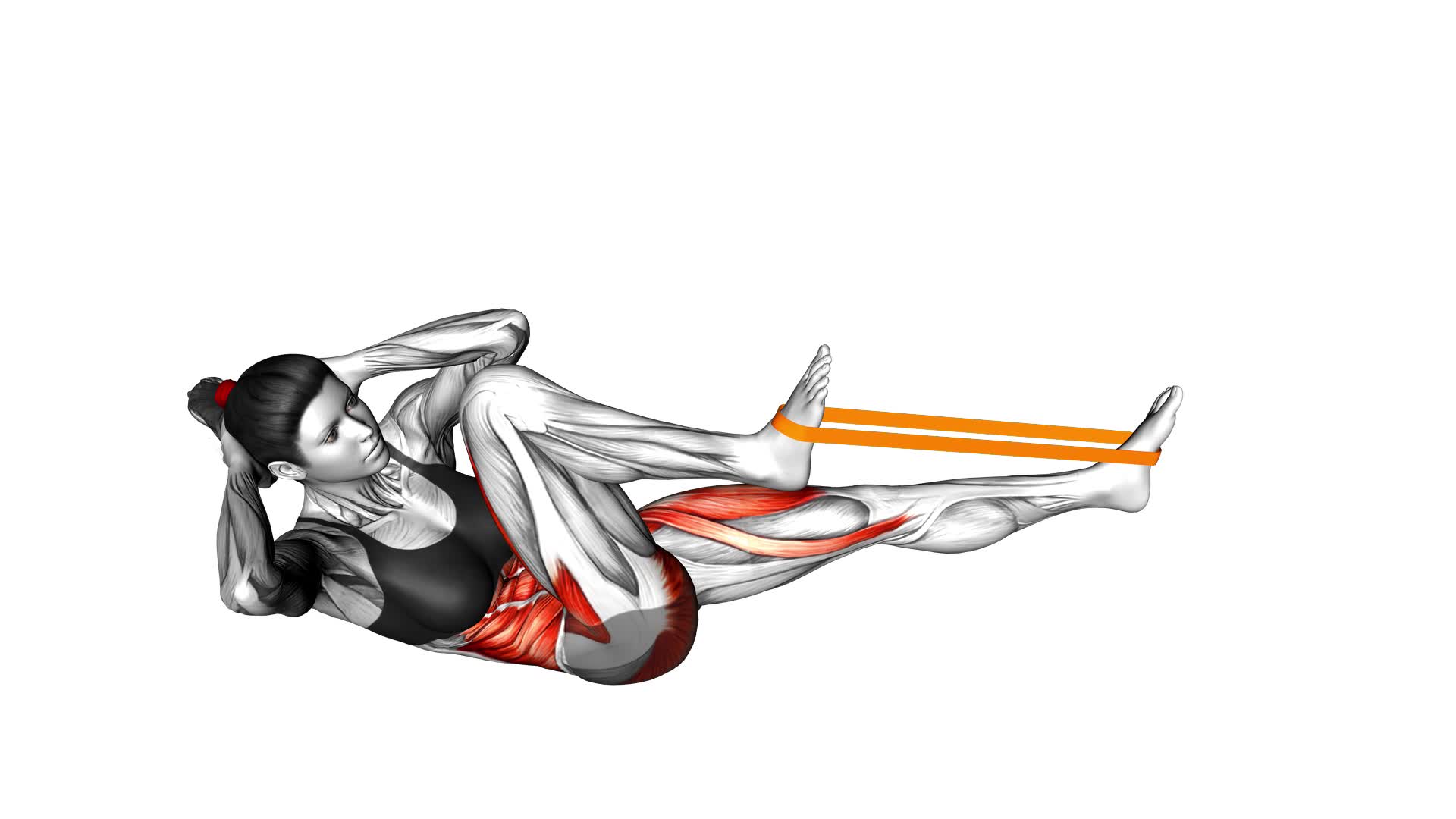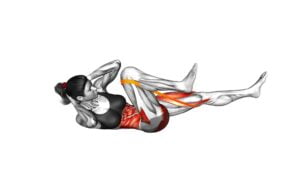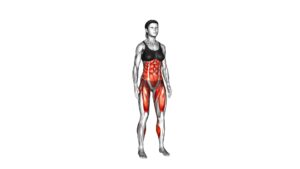Resistance Band Air Bike (female) – Video Exercise Guide & Tips

Are you looking for a challenging and effective workout that targets your core and strengthens your upper body? Look no further than the resistance band air bike!
Watch This Exercise Video
This video exercise guide and tips will show you how to properly perform this exercise using a resistance band. With advanced variations and progressions, you can take your workout to the next level.
Get ready to sweat and feel the burn with this dynamic and empowering workout!
Key Takeaways
- The Resistance Band Air Bike effectively engages core muscles and targets abs, obliques, and lower back.
- Proper form and technique, such as maintaining a strong core and avoiding excessive swinging or arching of the back, are crucial for performing the exercise correctly.
- Common form mistakes include allowing excessive arching of the lower back and rushing through the exercise without maintaining proper form.
- Upper body strengthening exercises with resistance bands, such as push-up variations and shoulder press techniques, can help develop overall upper body strength and improve posture.
Benefits of the Resistance Band Air Bike
What are the benefits of using the Resistance Band Air Bike?
The Resistance Band Air Bike is a fantastic alternative to traditional core workouts using resistance bands. By incorporating the resistance bands into the air bike exercise, you're able to engage your core muscles even more effectively. This exercise targets not only your abs, but also your obliques and lower back, resulting in a well-rounded core workout.
One of the major benefits of the Resistance Band Air Bike is its ability to strengthen your core muscles. As you pedal your legs in the air, the resistance bands provide constant tension, forcing your core to work harder to stabilize your body. This not only helps to build strength in your abs, but also improves your overall balance and stability.
Additionally, the Resistance Band Air Bike is a versatile exercise that can be modified to suit your fitness level. You can adjust the tension of the resistance bands by choosing bands with different levels of resistance. This allows you to progress and challenge yourself as you become stronger.
Proper Form and Technique
To execute the Resistance Band Air Bike with proper form and technique, it's essential to focus on core engagement throughout the movement. This means actively contracting your abdominal muscles and maintaining a strong and stable core.
By doing so, you'll maximize the effectiveness of the exercise and prevent common form mistakes such as excessive swinging or arching of the back.
Core Engagement During
Engage your core throughout the Resistance Band Air Bike exercise to maintain proper form and technique. Core stability is essential for this exercise as it helps to stabilize your body and prevent any unnecessary movements. By engaging your core, you'll activate your abdominal muscles, ensuring that they're working efficiently and effectively. This won't only enhance the effectiveness of the exercise but also help to develop abdominal strength.
To engage your core, imagine pulling your belly button towards your spine. This will activate your deep abdominal muscles and create a stable foundation for the exercise. Keep your core engaged throughout the entire movement, even when your legs are extended or your upper body is twisting. By doing so, you'll maintain proper alignment and prevent any strain on your lower back.
Now that you understand the importance of core engagement, let's move on to common form mistakes that you should avoid to get the most out of your Resistance Band Air Bike exercise.
Common Form Mistakes
To ensure proper form and technique during the Resistance Band Air Bike exercise, it's crucial that you avoid these common form mistakes.
- One common mistake is allowing your lower back to arch excessively during the movement. This not only puts unnecessary strain on your spine but also reduces the effectiveness of the exercise. To improve your form, focus on keeping your core engaged and your lower back pressed into the floor throughout the entire movement.
- Another common mistake is rushing through the exercise and sacrificing proper form. Remember to maintain a controlled and steady pace, ensuring that you fully extend your legs and twist your torso with each rep.
By avoiding these common mistakes and focusing on improving your form, you'll maximize the benefits of the Resistance Band Air Bike exercise.
Keep pushing yourself and strive for proper technique to achieve your fitness goals.
Targeting Your Core With Resistance Bands
You can effectively target your core by incorporating resistance bands into your workout routine. Resistance bands are a versatile and portable tool that can help you improve core stability and strengthen your abdominal muscles. Whether you're a beginner or an advanced fitness enthusiast, resistance bands can be customized to match your current fitness level.
One effective exercise to target your core with resistance bands is the standing woodchop. Start by attaching the resistance band to a stable object at chest height. Stand with your feet shoulder-width apart and hold the band with both hands. Begin the exercise by rotating your torso to one side and bringing your hands diagonally across your body, as if you're chopping wood. Engage your core muscles throughout the movement and repeat on the other side. This exercise targets your obliques, which are important for core stability and rotational movements.
Incorporating resistance bands into your core workouts can help you develop a strong and stable core, which is essential for overall fitness and daily activities. Once you've targeted your core, it's time to move on to upper body strengthening exercises.
Upper Body Strengthening Exercises
Are you looking to strengthen your upper body? Push-up variations are a great way to target your chest, shoulders, and triceps. By incorporating different hand placements and elevations, you can challenge your muscles in new ways.
Plank exercises, such as the high plank and side plank, engage your core while also working your arms, shoulders, and back.
Lastly, don't forget about shoulder press techniques using resistance bands. This exercise targets your deltoids and helps improve your overall upper body strength.
Push-Up Variations
For a challenging upper body workout, incorporate push-up variations into your fitness routine. Push-ups are a versatile exercise that target your chest and tricep muscles. By making modifications to the traditional push-up, you can further enhance the effectiveness and difficulty of the exercise.
One variation is the diamond push-up, where you form a diamond shape with your hands by touching your thumbs and index fingers together. This targets your triceps and inner chest muscles more intensely.
Another modification is the wide grip push-up, where you place your hands wider than shoulder-width apart. This emphasizes your chest muscles and helps to develop upper body strength.
To challenge yourself even more, try decline push-ups by elevating your feet on a stable surface. This increases the resistance on your upper body, particularly your shoulders and upper chest.
Plank Exercises
To continue building strength in your upper body, let's delve into plank exercises, which will engage your core muscles even further. Planks are a fantastic way to target your abs, back, shoulders, and arms all at once. There are several plank variations you can incorporate into your workout routine to keep it challenging and exciting.
One popular variation is the high plank, where you support your body weight on your hands and toes, with your arms fully extended. This variation primarily targets your core and upper body muscles. Another effective variation is the side plank, which focuses on strengthening your obliques and improving stability.
In addition to building upper body strength, plank exercises offer numerous benefits. They improve posture, enhance balance, and increase overall core stability. Planks also help to prevent lower back pain, as they engage the muscles that support your spine.
Incorporating plank exercises into your workout routine won't only strengthen your upper body, but also improve your overall fitness level. So, challenge yourself with different plank variations and reap the amazing benefits they've to offer.
Shoulder Press Techniques
To effectively strengthen your upper body, incorporate shoulder press techniques into your workout routine. Shoulder press exercises are highly effective in targeting your shoulder muscles and can be done using different variations.
One common variation is the dumbbell shoulder press, where you hold a dumbbell in each hand and press them overhead. This exercise engages your deltoids, trapezius, and triceps, helping to build strength and definition in your upper body.
Another variation is the barbell shoulder press, where you use a barbell instead of dumbbells. This exercise allows you to lift heavier weights and target your shoulder muscles more intensively.
The benefits of shoulder press exercises include improved shoulder stability, increased upper body strength, and enhanced posture. Start incorporating shoulder press variations into your workout routine to achieve a stronger and more defined upper body.
Advanced Variations and Progressions
As you progress in your Resistance Band Air Bike workouts, you can challenge yourself even further with advanced variations and progressions. These advanced variations will take your workout to the next level, targeting different muscles and increasing the intensity.
Here are three advanced variations and progressions to try:
- Single-arm Resistance Band Air Bike: Instead of using both arms, perform the exercise with just one arm at a time. This will require more stability and core strength as you balance and control the resistance band.
- Tempo Variation: Slow down the movement and focus on the eccentric phase of the exercise. By extending the time it takes to complete each rep, you'll increase the time under tension and engage your muscles even more.
- Resistance Band Air Bike with Leg Raise: Incorporate a leg raise into the exercise by lifting one leg off the ground as you perform the air bike motion. This will further engage your abdominal muscles and challenge your balance and coordination.
By incorporating these advanced variations and progressions into your Resistance Band Air Bike workouts, you'll continue to challenge your body and see greater results.
Now, let's move on to some tips for a successful resistance band air bike workout.
Tips for a Successful Resistance Band Air Bike Workout
Maximize the effectiveness of your Resistance Band Air Bike workout with these tips for a successful session.
To get the most out of your workout, consider making resistance band modifications. By incorporating different band tensions or adding multiple bands, you can increase the challenge and target specific muscle groups. For example, using a heavier band will provide more resistance, while using a lighter band will be easier for beginners. Experiment with different band placements, such as around your thighs or ankles, to engage different muscles and add variety to your routine.
In addition to resistance band modifications, paying attention to your breathing technique is crucial. Proper breathing can enhance your workout by providing more oxygen to your muscles and improving your endurance. As you perform the air bike exercise, exhale forcefully through your mouth as you bring your knee towards your chest, and inhale deeply through your nose as you extend your leg. This breathing pattern will help you maintain control and maximize your power output throughout the exercise.
Remember, the key to a successful Resistance Band Air Bike workout is to challenge yourself while maintaining proper form and technique. By incorporating resistance band modifications and practicing effective breathing techniques, you can make the most out of your workout session and achieve your fitness goals.
Stay motivated, push yourself, and enjoy the benefits of this dynamic exercise. You've got this!
Frequently Asked Questions
How Long Should I Rest Between Sets During a Resistance Band Air Bike Workout?
When doing a resistance band air bike workout, it's important to consider your rest periods between sets. Resting between sets allows your muscles to recover and prepares you for the next round of exercises.
The length of your rest periods will depend on your intensity levels and fitness goals. Generally, it's recommended to rest for about 30 to 90 seconds between sets. However, if you're aiming for more endurance, you can shorten the rest periods, while longer rest periods may be needed for building strength.
Can Resistance Band Air Bike Exercises Help With Weight Loss?
Resistance band air bike exercises can be a great addition to your weight loss routine. They offer a unique cardio workout that targets your core, arms, and legs.
Compared to other cardio exercises, they provide resistance which can help build muscle and burn more calories.
To properly perform resistance band air bike exercises for maximum weight loss, make sure to maintain proper form, engage your core, and keep a steady pace.
Stay consistent and motivated, and you'll see the results you desire.
Are There Any Modifications for Individuals With Lower Back Pain During the Resistance Band Air Bike Exercise?
If you have lower back pain and want to do the resistance band air bike exercise, there are modifications you can try. By adjusting the intensity and range of motion, you can reduce strain on your lower back.
These modifications can help protect your spine while still working your core muscles for improved strength and stability.
Don't let back pain hold you back from reaping the benefits of this exercise. Give it a try and see how it feels for you.
Can I Incorporate the Resistance Band Air Bike Into My Existing Workout Routine?
Yes, you can definitely incorporate the resistance band air bike into your existing workout routine.
This exercise provides a great alternative to traditional air bike exercises, as it adds resistance to your movements.
The resistance band air bike helps strengthen your core, legs, and upper body, all while improving your cardiovascular endurance.
By incorporating this exercise into your routine, you'll reap the benefits of increased strength, endurance, and overall fitness.
How Do I Choose the Right Resistance Band for My Fitness Level When Performing the Air Bike Exercise?
When choosing the right resistance band for the air bike exercise, consider your fitness level. Start with a band that provides enough resistance to challenge your muscles, but not too much that it causes strain or discomfort.
It's important to maintain proper form throughout the exercise to prevent injury. Remember to engage your core, keep your back straight, and pedal with control.
Gradually increase the resistance as you get stronger to continue progressing in your fitness journey.
Conclusion
In conclusion, the resistance band air bike is a highly effective exercise that targets your core and strengthens your upper body. By using resistance bands, you can add an extra challenge to your workout routine and achieve even better results.
Remember to maintain proper form and technique throughout the exercise to maximize its benefits. With dedication and consistency, you can achieve your fitness goals and improve your overall strength and endurance.
So grab your resistance bands and get ready for an intense and rewarding workout!

Author
Years ago, the spark of my life’s passion ignited in my mind the moment I stepped into the local gym for the first time. The inaugural bead of perspiration, the initial endeavor, the very first surge of endorphins, and a sense of pride that washed over me post-workout marked the beginning of my deep-seated interest in strength sports, fitness, and sports nutrition. This very curiosity blossomed rapidly into a profound fascination, propelling me to earn a Master’s degree in Physical Education from the Academy of Physical Education in Krakow, followed by a Sports Manager diploma from the Jagiellonian University. My journey of growth led me to gain more specialized qualifications, such as being a certified personal trainer with a focus on sports dietetics, a lifeguard, and an instructor for wellness and corrective gymnastics. Theoretical knowledge paired seamlessly with practical experience, reinforcing my belief that the transformation of individuals under my guidance was also a reflection of my personal growth. This belief holds true even today. Each day, I strive to push the boundaries and explore new realms. These realms gently elevate me to greater heights. The unique combination of passion for my field and the continuous quest for growth fuels my drive to break new ground.



